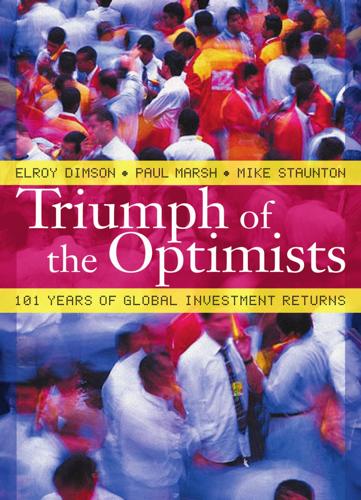
Triumph of the Optimists: 101 Years of Global Investment Returns
by
Elroy Dimson
,
Paul Marsh
and
Mike Staunton
Published 3 Feb 2002
If equities were to perform well when consumption dips, then equities would be a good hedge against cutbacks in consumption. The equity premium should be large if equities are a poor diversification tool. In other words, the equity premium should be larger when there is a high correlation between stock market returns and consumption. The equity premium should also be larger when consumers are willing to pay more for insurance against the prospect of reduced consumption. That is, the equity premium should vary positively with the risk aversion of households as well as with the correlation of equity returns and consumption.
…
Alternatively, the large ex post risk premium may reflect rewards from bills and bonds that fell short of expectations: this is Weil’s (1989) risk free rate puzzle that safe investment has been under-rewarded. We note in chapter 13 that making inferences from the world equity premium mitigates the impact of measurement errors and market survival. The global equity premium is therefore a good place to start for prediction. In chapter 12 we compute a world geometric-mean equity premium, relative to treasury bills, that historically averaged 4.9 percent. In chapter 13 we estimate the prospective equity premium for this sixteen-country world index to be approximately 3.0 percent (geometric mean) or 4.0 percent (arithmetic mean). Chapter 14 Implications for investors 203 In Figure 14-5 we use the expected geometric mean premium of 3.0 percent to examine the range of risk premia that can be anticipated over various future time horizons.
…
In reality, however, aggregate consumption changes gradually over time, is not very volatile, and is not obviously correlated with stock market performance. There is a puzzle as to whether the large, historical US equity premium can conceivably be consistent with a focus by households on their potential future consumption. The “equity premium puzzle,” first formulated by Mehra and Prescott (1985), thus remains a source of controversy. As Kocherlakota (1996) and Shleifer (2000) point out, traditional finance theory suggests that the equity premium should be much smaller than the (US) historical average. Chapter 13 The prospective risk premium 181 As one might expect, there are competing theories that suggest differing magnitudes for the risk premium (see Cornell (1999) for a review).
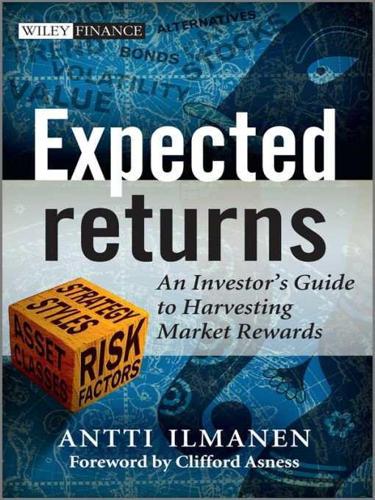
Expected Returns: An Investor's Guide to Harvesting Market Rewards
by
Antti Ilmanen
Published 4 Apr 2011
The other important distinction among equity premium concepts is between the ex post equity premium (historical realized excess return) and the ex ante equity premium (forward-looking excess return):• both can be measured either as an arithmetic average or a geometric average; • the latter may be based on objectively feasible future returns (rational expectations) or subjective return expectations (that are possibly irrational). Thus, the label “ERP” can be misleading if non-risk considerations cause equities’ ex ante return advantage. The equity premium is ideally computed for stock market indices that weight each constituent stock by its market capitalization.
…
They focus on a more direct measure of relative sentiment and show that when the share of retail investable wealth held in equity relative to the share of total investable wealth held in equity is high (low), subsequent stock market returns tend to be low (high). Academics. Even academic views on the equity premium have evolved during the past decade—perhaps reflecting a shift from basing equity premium estimates on historical average returns to basing them on forward-looking analysis like the DDM. Ivo Welch has polled hundreds of finance professors about their view on the equity premium on four occasions: 1997–1998, August 2001, December 2007, and January 2009. His main survey question focuses on the (arithmetic) 30-year equity premium (over short-dated Treasury bills, so the premium is slightly higher than the equity–bond premium).
…
The model thus implies that investors’ risk attitudes become more conservative in down-markets. The next section shows that estimates of the equity premium have edged lower since the 1990s. During the Great Moderation years, it was popular to argue that lower macro-volatility and investor learning about equities’ long-run return advantage could justify a sustained fall in the required equity premium. Such arguments ring hollow after the 2008 experience. Yet, it remains plausible that the fair premium has declined somewhat due to lower trading costs and better global diversification opportunities. 8.3 HISTORICAL EQUITY PREMIUM Table 8.1 and Figure 8.1 recap the U.S. experience since the 19th century, documenting compound (geometric) nominal and real returns as well as equity premia over cash (mainly one-month Treasury bills) and over bonds (mainly 10-year Treasury bonds).
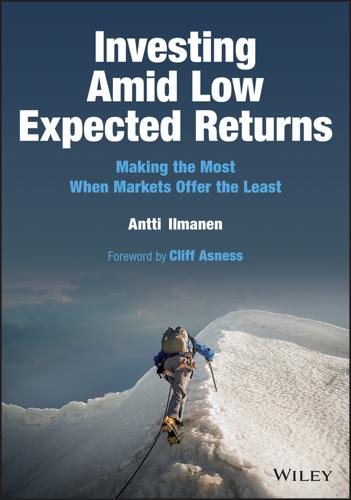
Investing Amid Low Expected Returns: Making the Most When Markets Offer the Least
by
Antti Ilmanen
Published 24 Feb 2022
If you instead hold unhedged foreign assets and if exchange rates do not change (a big if, though a random-walk assumption is a decent base case), the expected total return is the same for you as for the foreign asset's domestic holder. 4.2. Equity Premium The equity risk premium is clearly the most important risk premium both for real-world investors and in the academic literature. According to one-factor asset pricing models like the Capital Asset Pricing Model (CAPM), it is the only premium that influences assets' expected returns. Public equities are the largest allocation in many investor portfolios. The equity premium dominates these portfolios' risk even more because equities are more volatile than most other asset classes and because the premium is also embedded in many assets outside public equities (e.g. high-yield bonds, hedge funds, private equity).
…
The best resource on historical equity premia are Dimson-Marsh-Staunton yearbooks, which by 2021 cover up to 90 countries, though 32 included in the main results and “only” 21 having the full 121-year history, 1900–2020. For global equities, the total annual compound return or geometric mean is 8.3% (9.7% arithmetic mean7). The corresponding real return is 5.3% (6.7%), equity premium over US bills 4.4% (5.9%), equity premium over bonds 3.1% (4.3%), and SR 0.35.8 Figure 4.4 shows four different performance metrics for five multi-country composites: World (the middle bar), its split to the US and World-ex-US, and an alternative split to Developed and Emerging Markets.9 Whichever metric we use, equities have a proud history behind them, with statistically and economically significant positive premia.10 Figure 4.4 Average Compound Returns and Premia for Global Equities, 1900–2020 Source: Data from Dimson-Marsh-Staunton (2021).
…
These can mitigate career risk considerations (“either I replace this losing investment, or I may be replaced”) in cases where decision-makers still believe in a strategy's long-term prospects. Conventionality: Only the equity premium is easily forgiven a losing decade. (Few investors deallocated fully from equities after the 2000–09 losses.) Equity market exposure is the common and conventional way to lose money, and this helps beyond the well-founded conviction investors have in the long-term equity premium. One could even argue that any active risk taking requires multiyear patience, and without it, investors should prefer to stay passive.10 Gradualism: Many investors are especially concerned about the performance of a new strategy “out of the gate.”
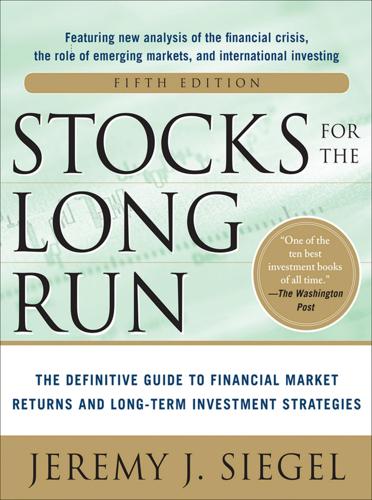
Stocks for the Long Run 5/E: the Definitive Guide to Financial Market Returns & Long-Term Investment Strategies
by
Jeremy Siegel
Published 7 Jan 2014
Only extreme risk aversion can explain why investors were willing to accept negative after-inflation returns on government bonds even though other assets, such as equities, have consistently delivered long-term real returns of 6 to 7 percent per year. THE EQUITY PREMIUM The excess return of stocks over bonds (either long or short) is referred to as the equity risk premium, or simply the equity premium. It can be measured historically, as shown in Figure 5-6, or prospectively, on the basis of current bond yields and stock valuations. Subtracting stock and bond returns from Tables 5-1 and 5-2 shows that the equity premium has averaged 3.0 percent against Treasury bonds and 3.9 percent against Treasury bills over the entire 210 years. FIGURE 5-6 The Equity Premium: Difference between 30 Year Return on Stocks and Bonds and Stocks and Bills 1831–2012 Because of the extraordinary returns on long-term bonds over the past 30 years, the historical equity premium of stocks over bonds has shrunk to zero.
…
FIGURE 5-6 The Equity Premium: Difference between 30 Year Return on Stocks and Bonds and Stocks and Bills 1831–2012 Because of the extraordinary returns on long-term bonds over the past 30 years, the historical equity premium of stocks over bonds has shrunk to zero. But the forward-looking equity premium at the end of 2013 is far higher since the prospective real yields on long bonds have fallen so low. If forward-looking equity returns match their historical average, the forward-looking equity premium in 2013 could be 6 percent or more.15 WORLDWIDE EQUITY AND BOND RETURNS When I published Stocks for the Long Run in 1994, some economists questioned whether my conclusions, drawn from data from the United States, might overstate historical equity returns measured on a worldwide basis.
…
Whatever the reasons, such a decline implies that the real return on equity need not be as high as it had been historically in order to attract buyers. We have noted that the historical premium (the equity premium) on holding stocks over bonds has been approximately 3 to 3½ percent. If we assume that the long-run real rate settles at 2 percent, about 1 to 1½ percent below its long-run average, then a 3 percent equity premium will require a 5 percent real return on stocks, which, as we noted above, arises from a 20 P/E multiple. The Equity Risk Premium The decline in transaction costs and the decline in discount rates may each be used to justify a higher P/E ratio.
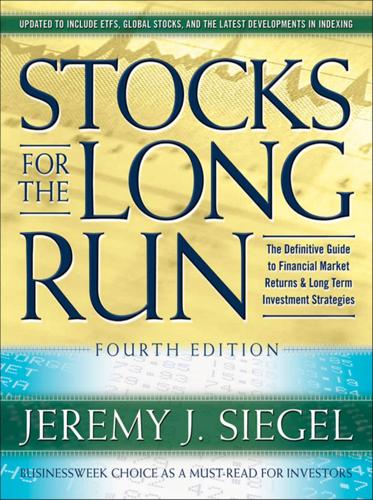
Stocks for the Long Run, 4th Edition: The Definitive Guide to Financial Market Returns & Long Term Investment Strategies
by
Jeremy J. Siegel
Published 18 Dec 2007
The excess return for holding equities over short-term bonds is plotted in Figure 1-5, and it is referred to as the equity risk premium, or simply the equity premium.16 The equity premium, calculated as the difference in 30-year compound annual real returns on stocks and bills, averaged 1.4 percent in the first subperiod, 3.4 percent in the second subperiod, and 5.9 percent since 1926. The abnormally high equity premium since 1926 is certainly not sustainable. It is not a coincidence that the highest 30-year average eq16 For a rigorous analysis of the equity premium, see Jeremy Siegel and Richard Thaler, “The Equity Premium Puzzle,” Journal of Economic Perspectives, vol. 11, no. 1 (Winter 1997), pp. 191–200, and more recently, “Perspectives on the Equity Risk Premium,” Financial Analysts Journal, vol. 61, no. 1 (November/December 2005), pp. 61–73, reprinted in Rodney N.
…
They claimed that economic models predicted that either the rate of return on stocks should be lower, or the rate of return on fixed-income assets should be higher, or both. In fact, according to their studies, an equity premium as low as 1 percent or less could be justified.15 Mehra and Prescott were not the first to believe that the equity premium derived from historical returns was too large. Fifty years earlier Professor Chelcie Bosland of Brown University had stated that one of the consequences of the spread of knowledge of superior stock returns in the 1920s as a result of Edgar Lawrence Smith’s contributions would be a narrowing of the equity premium: Paradoxical though it may seem, there is considerable truth in the statement that widespread knowledge of the profitability of common stocks, gained from the studies that have been made, tends to diminish the likelihood that correspondingly large profits can be gained from stocks in the future.
…
But over the long run, the superior performance of equities is so overwhelming, I wonder why anyone doesn’t hold stocks! IC: Exactly. Shlomo Bernartzi and Richard Thaler claim that myopic loss aversion is the key to solving the equity premium puzzle.27 For years, econ26 Shlomo Bernartzi and Richard Thaler, “Myopic Loss Aversion and the Equity Premium Puzzle,” Quarterly Journal of Economics, 1995, pp. 73–91. 27 See Chapter 8 for a further description of the equity premium puzzle. CHAPTER 19 Behavioral Finance and the Psychology of Investing 333 omists have been trying to figure out why stocks have returned so much more than fixed-income investments.
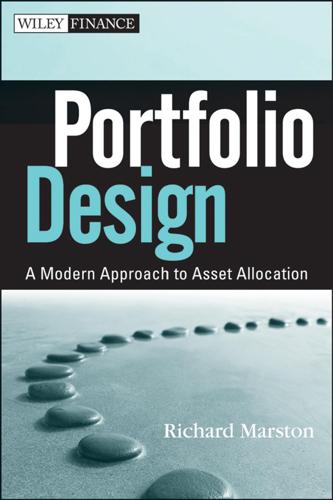
Portfolio Design: A Modern Approach to Asset Allocation
by
R. Marston
Published 29 Mar 2011
The excess return of stocks over the risk-free return has been given a specific name, the equity premium. Using geometric averages, the equity premium is defined as Equity premium = (1 + rS&P )/(1 + rF ) − 1 = (1 + 0.107)/(1 + 0.048) − 1 = 5.6% where rS&P is the return on the S&P 500 and rF is the risk-free Treasury bill return.5 Sometimes the equity premium is defined by using the long-term bond rather than the risk-free return in which case the premium would be 4.4 percent rather than 5.6 percent. If the entire period from 1926 to present is studied, a period that includes the depression of the 1930s, the equity premium (defined relative to the risk-free return) is 5.9 percent.
…
If the entire period from 1926 to present is studied, a period that includes the depression of the 1930s, the equity premium (defined relative to the risk-free return) is 5.9 percent. However it is defined, the equity premium is remarkably large. This premium has provided equity investors with a rich reward for bearing the extra risk of owning equities. In a landmark study more than two decades ago, Mehra and Prescott (1985) showed that the equity premium is inconsistent with reasonable levels of risk aversion. They called the premium a puzzle. Since then, scores of finance researchers have set out to develop theoretical models of investor behavior that could explain the size of the premium.6 Researchers have also studied the equity premium in other countries. A book by Dimson, Marsh, and Staunton (2002) estimates the equity premium for 16 industrial countries from 1900 to 2000 as ranging P1: OTA/XYZ P2: ABC c02 JWBT412-Marston December 20, 2010 16:59 Printer: Courier Westford 24 PORTFOLIO DESIGN from 1.8 percent for Denmark to 7.4 percent for France, with an average equity premium of 4.9 percent.
…
A book by Dimson, Marsh, and Staunton (2002) estimates the equity premium for 16 industrial countries from 1900 to 2000 as ranging P1: OTA/XYZ P2: ABC c02 JWBT412-Marston December 20, 2010 16:59 Printer: Courier Westford 24 PORTFOLIO DESIGN from 1.8 percent for Denmark to 7.4 percent for France, with an average equity premium of 4.9 percent. Wise investors don’t spend too much time agonizing over the source of the premium. They simply take advantage of it by focusing on equities in their portfolios. HOW MUCH MORE ATTRACTIVE ARE STOCKS THAN BONDS? Many investors, though, see the equity premium as a necessary price for the extra risk of investing in stocks.
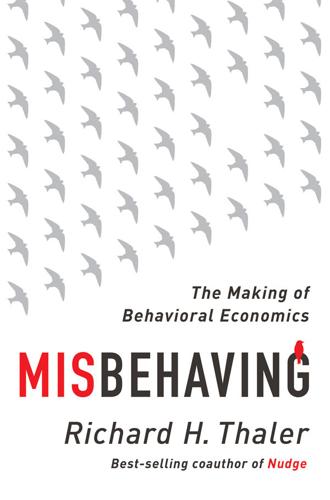
Misbehaving: The Making of Behavioral Economics
by
Richard H. Thaler
Published 10 May 2015
I suspect he found this one to be a bit embarrassing given his worldview, but he and Mehra knew they were on to something interesting. The term “equity premium” is defined as the difference in returns between equities (stocks) and some risk-free asset such as short-term government bonds. The magnitude of the historical equity premium depends on the time period used and various other definitions, but for the period that Mehra and Prescott studied, 1889–1978, the equity premium was about 6% per year. The fact that stocks earn higher rates of return than Treasury bills is not surprising. Any model in which investors are risk averse predicts it: because stocks are risky, investors will demand a premium over a risk-free asset in order to be induced to bear that risk.
…
What makes the analysis by Mehra and Prescott special is that they went beyond asking whether economic theory can explain the existence of an equity premium, and asked if economic theory can explain how large the premium actually is. It is one of the few tests I know of in economics where the authors make a statement about the permissible magnitude of some effect.† After crunching the numbers, Mehra and Prescott concluded that the largest value of the equity premium that they could predict from their model was 0.35%, nowhere near the historical 6%.‡ Investors would have to be implausibly risk averse to explain the historical returns.
…
Simply texting patients to remind them to take their prescribed medications (in this study, for lowering blood pressure or cholesterol levels) reduced the number of patients who forgot or otherwise failed to take their medications from 25% to 9% (Wald et al., 2014). † They were able to do this because, for technical reasons, the standard theory makes a prediction about the relation between the equity premium and the risk-free rate of return. It turns out that in the conventional economics world, when the real (inflation-adjusted) interest rate on risk-free assets is low, the equity premium cannot be very large. And in the time period they studied, the real rate of return on Treasury bills was less than 1%. ‡ That might not look like a big difference, but it is huge. It takes seventy years for a portfolio to double if it’s growing at 1% per year, and fifty-two years if it’s growing at 1.35%, but only ten years if it’s growing at 7%
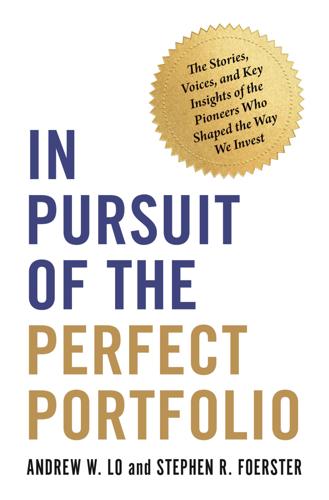
In Pursuit of the Perfect Portfolio: The Stories, Voices, and Key Insights of the Pioneers Who Shaped the Way We Invest
by
Andrew W. Lo
and
Stephen R. Foerster
Published 16 Aug 2021
The Puzzling Premium In 1992, Siegel published three articles that combined his economic background with his investment interests and his forte in creatively analyzing data. All three articles tried to solve the puzzling results of Rajnish Mehra and Nobel laureate Edward Prescott, who attempted to measure what is known as the “equity premium.”22 To explain the puzzle, we’ll need some background. The equity premium is the difference between the return on equities (such as the market portfolio) and a risk-free yield, such as the yield on Treasury bills. The equity premium is important because it helps us to estimate the cost of equity, which in turn helps us estimate the intrinsic value of stocks. It’s also important in regulated industries such as utilities, where fair returns are prescribed that, in turn, determine the utility price.
…
Given this variation, he concluded that it was possible that a shift in sentiment between the most optimistic forecasters and the most pessimistic was a key factor in the 1987 crash. Several years later, Siegel returned to investigating the equity premium with the future Nobel laureate Richard Thaler.27 They investigated the empirical results of previous studies that tried to explain the equity premium (including Siegel’s 1992 articles) and commented on the extent to which those papers solved the puzzle. Siegel’s earlier article suggested that a longer time period was warranted when calculating the equity premium. Other studies suggested that there was a survivorship bias in the data: by focusing on a single market (the United States) with a growing economy and a vibrant stock market over the centuries, the data overlooked the rational worries of investors who thought there may be a small chance of an economic catastrophe.
…
Other studies suggested that there was a survivorship bias in the data: by focusing on a single market (the United States) with a growing economy and a vibrant stock market over the centuries, the data overlooked the rational worries of investors who thought there may be a small chance of an economic catastrophe. Siegel and Thaler also examined several theoretical explanations to solve the equity premium puzzle, including different models about the levels of risk aversion found among investors to account for their behavioral biases, that explain much but not all of the puzzle. In their commentary, Siegel and Thaler argued that the equity premium should remain positive but at a lower level—around 3 percent. They used an analogy to Rip Van Winkle to imagine an investor who makes an asset allocation decision, then goes to sleep for twenty years.
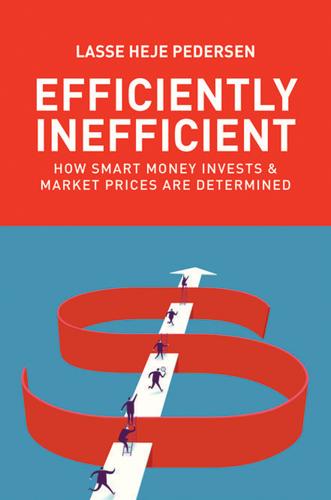
Efficiently Inefficient: How Smart Money Invests and Market Prices Are Determined
by
Lasse Heje Pedersen
Published 12 Apr 2015
Hence, a typical stock with a 2% dividend yield and a 3.5% dividend growth rate has an expected return of 5.5% over the long term. We can further compute the equity premium, that is, the expected return on equities in excess of the risk-free rate. The equity premium is important because it tells by how much equities are expected to beat cash and it should be viewed as the current market compensation for the risk in equities. Of course, the equity premium depends both on the expected equity return and the current risk-free interest rates. Given that the current interest rates are near zero, this means that the equity premium is also about 5.5%, under the same assumptions as above. A more typical nominally risk-free interest rate might be around 3 to 4%, that is, a 1 to 2% real rate plus 2% inflation.
…
A more typical nominally risk-free interest rate might be around 3 to 4%, that is, a 1 to 2% real rate plus 2% inflation. With an interest rate of 3%, the equity premium would only be 2.5% under the maintained assumptions, but of course, all these numbers are subject to significant uncertainty. The historical U.S. equity premium over cash has been about 7 to 8% per year from 1926 to 2013, but it has been lower in most other countries. This high historical U.S. equity premium can be decomposed as follows: The historical average dividend yield was 3.9%, almost double its current value. The dividend growth rate was 4.6%, higher than my estimate above due to higher historical inflation of about 3%.
…
A one percentage point higher dividend yield translates into a 2.3 percentage point higher estimated expected price appreciation such that the total equity premium increases by 3.3 percentage points. The t-statistic of the estimate is 2.8, indicating that the coefficient appears significantly different from zero,3 but the estimated standard error of 1.2 also means that the coefficient could really be anywhere between 3.3 − 2 × 1.2 = 1 and 3.3 + 2 × 1.2 = 6, a wide range. The estimated coefficients imply that the equity premium varies significantly as the dividend changes over time. For instance, the lowest observed dividend yield of 1.1% happened in 2000 during the height of the Internet bubble.

Irrational Exuberance: With a New Preface by the Author
by
Robert J. Shiller
Published 15 Feb 2000
Consideration of the fact that issues are made below market price might be interpreted as suggesting lowering the terminal value for the dividend present value below the amount shown in Figure 9.1. Chapter Ten Investor Learning—And Unlearning 1. Economists have long puzzled over why the equity premium has been so high historically. How, they wonder, can it be that over the years people haven’t invested more in stocks, given that stocks so outperform other investments? See Raj Mehra and Edward C. Prescott, “The Equity Premium Puzzle,” Journal of Monetary Economics, 15 (1988): 145–61. According to the learning theory discussed in this chapter, the equity premium puzzle is supposed to be a thing of the past— people have finally wised up. 2. Edgar Lawrence Smith, Common Stocks as Long-Term Investments (New York: Macmillan, 1924). 3.
…
Armed with this new knowledge, investors have now bid stock prices up to a higher level, to their rational or true level, where the stocks would have been all along had there not been excessive fear of them. Stocks, selling now at a higher price, will pay a correspondingly lower yield—but that is all right with investors, since they now know that stocks are not all that risky. In other words, the equity premium, the extra return that people require to be compensated for the risk of investing in the stock market, has gone down because investors have suddenly come to appreciate the historical record of stock market risk.1 It is true that the public does appear to perceive less risk in the stock market than they did ten years ago.
…
French and Richard Roll, “Stock Return Variances: The Arrival of Information and the Reaction of Traders,” Journal of Financial Economics, 17 (1986): 5–26; see also Richard Roll, “Orange Juice and Weather,” American Economic Review, 74 (1984): 861–80. 36. See Shlomo Benartzi and Richard H. Thaler, “Myopic Loss Aversion and the Equity Premium Puzzle,” Quarterly Journal of Economics, 110(1) (1995): 73–92. 37. Data are from the National Gambling Impact Study Commission, Final Report, Washington D.C., 1999, http://www.ngisc.gov/reports/exsum_1-7.pdf. 38. See also William N. Thompson, Legalized Gambling: A Reference Handbook (Santa Barbara, Calif.: ABC-CLIO, 1994), pp. 52–53. 39.
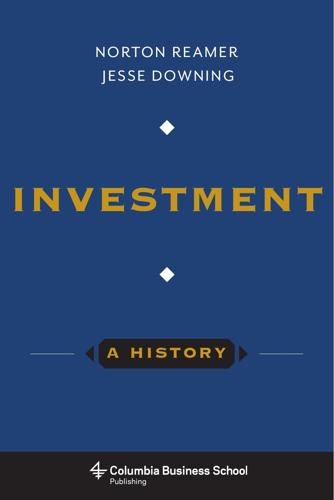
Investment: A History
by
Norton Reamer
and
Jesse Downing
Published 19 Feb 2016
Prospect theory contends that individuals’ choices are more centered on changes in utility or wealth rather than end values; it also suggests that most people exhibit loss aversion in which losses cause more harm to one’s welfare than the benefit from happiness one receives from gaining the same amount of reward.46 This theory may seem intellectually interesting, but how does it relate precisely to finance and investing? Since Kahneman and Tversky’s seminal paper, subsequent work has made many connections to markets, one of which is the “equity premium puzzle.” The equity premium puzzle was described first in a 1985 paper by Rajnish Mehra and Edward Prescott.47 The central “puzzle” is that while investors should be compensated more for holding riskier equities than holding the risk-free instrument (Treasury bills), the amount by which they are compensated seems extremely excessive historically.
…
Daniel Kahneman and Amos Tversky, “Prospect Theory: An Analysis of Decision under Risk,” Econometrica 47, no. 2 (March 1979): 265–278. 47. Rajnish Mehra and Edward C. Prescott, “The Equity Premium: A Problem,” Journal of Monetary Economics 15, no. 2 (March 1985): 145–161. 48. Stephen J. Brown, William N. Goetzmann, and Stephen A. Ross, “Survival,” Journal of Finance 50, no. 3 (July 1995): 853–873. 49. Shlomo Benartzi and Richard H. Thaler, “Myopic Loss Aversion and the Equity Premium Puzzle,” Quarterly Journal of Economics 110, no. 1 (February 1995): 73–92. 50. Burton G. Malkiel, “The Efficient Market Hypothesis and Its Critics,” Journal of Economic Perspectives 17, no. 1 (Winter 2003): 61–62. 8.
…
Investors who frequently look at the value of their equity portfolio—say, on a daily or weekly basis when the market behaves randomly over these short time frames, moving up and down—will thus experience more disutility on average, given that they derive greater pain from losses than pleasure from the same magnitude of gains. Over long evaluation periods, The Emergence of Investment Theory 253 however, where market movements have a general upward trend, this feeling of loss aversion is reduced because equities tend to appreciate over time, so it is more palatable to hold on to equities. The size of the equity premium, then, is really due to loss aversion experienced by investors whose frequency of evaluations is too great; if investors looked at their equities portfolios over longer time frames, they would demand lower premiums and this puzzle would be resolved.49 Other explanations that have been offered by behavioral economists focus on earnings uncertainty and how that influences investors’ willingness to bear risk, and yet others develop a dynamic loss aversion model where investors react differently to stocks that fall after a run-up compared to those that fall directly after purchase.

Culture and Prosperity: The Truth About Markets - Why Some Nations Are Rich but Most Remain Poor
by
John Kay
Published 24 May 2004
On July 15,2002, they dropped by 5% in the morning and rose 5% in the afternoon. These movements could not possibly be explained by new information about company prospects. The most important market anomaly is that the "equity premium"-the historic difference between the return on stocks and shares and the return on risk-free assets-seems much too high. As financial economists have debated the "equity premium paradox," estimates of the size of the premium have fallen. 7 Even so, an average return of 4% to 5% over safe assets seems far more than is needed to compensate for extra risks. If equity returns were indeed so high, shares would almost certainly outperform bonds over all but the shortest periods of time.
…
Glossary { 363} Falling average costs of production that are the result of higher levels of output. efficient market hypothesis The theory that information about the past and future prices of securities is fully incorporated in their prices. Takes a weak form (past data conveys no information), semistrong form (all publicly available information is incorporated), strong form (all information, whether public or not, is incorporated). The difference between returns on stocks equity premium (shares) and returns on risk-free assets. An agreement to buy or sell a commodity or futures contract security at a future date at a fixed price agreed now. A position in which all competitive markets in general (competitive) an economic system are simultaneously in equilibrium equilibrium. The total value of output (before gross domestic product depreciation) produced within the boundaries of a state.
…
A Smith (1976), chap. 7, pt. 1. See Shiller (2000), pages 142-46 for a demonstration that only the methods of empirical research have changed. Shleifer (1999), Siegel (1998), survey market anomalies. The January effect is discussed by Siegel, page 254, the 1987 crash by Shiller (2000), pages 88-95. The equity premium paradox was first described by Mehra and Prescott (1985) and elaborated by Benartzi and Thaler (1995). See Dimson et al. (2002) for evidence on it. Haigh (1999) gives a thoughtful discussion of the structure oflotteries. Thomson (1998) p.125. The settlement with Proctor and Gamble was only one of several pieces of litigation that engulfed Bankers Trust.
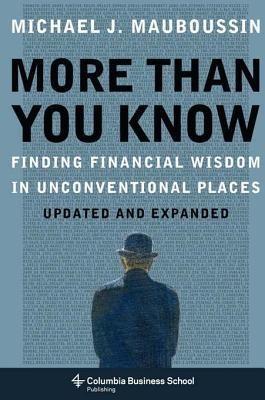
More Than You Know: Finding Financial Wisdom in Unconventional Places (Updated and Expanded)
by
Michael J. Mauboussin
Published 1 Jan 2006
Thaler, Amos Tversky, Daniel Kahneman, and Alan Schwartz, “The Effect of Myopia and Loss Aversion on Risk Taking: An Experimental Test” Loss aversion . . . can be considered a fact of life. In contrast, the frequency of evaluations is a policy choice that presumably could be altered, at least in principle. —Shlomo Benartzi and Richard H. Thaler, “Myopic Loss Aversion and the Equity Premium Puzzle” One or One Hundred In the early 1960s, economist Paul Samuelson offered his lunch colleagues a bet where he would pay $200 for a correct call of a fair coin toss and he would collect $100 for an incorrect call. But his partners didn’t bite. One distinguished scholar replied, “I won’t bet because I would feel the $100 loss more than the $200 gain.
…
In the six years that ended with 1993, Miller’s Special Investment Trust beat the market every year. 8. Time Is on My Side 1 Paul A. Samuelson, “Risk and Uncertainty: A Fallacy of Large Numbers,” Scientia 98 (1963): 108-13; reprinted at www.casact.org/pubs/forum/94sforum/94sf049.pdf. Shlomo Benartzi and Richard H. Thaler, “Myopic Loss Aversion and the Equity Premium Puzzle,” The Quarterly Journal of Economics 110, no. 1 (February 1995): 73-92, available from http://gsbwww.uchicago.edu/fac/richard.thaler/research/myopic.pdf, write: “Specifically, the theorem says that if someone is unwilling to accept a single play of a bet at any wealth level that could occur over the course of some number of repetitions of the bet, then accepting the multiple bet is inconsistent with expected utility theory.” 2 Daniel Kahneman and Amos Tversky, “Prospect Theory: An Analysis of Decision Under Risk,” Econometrica 47 (1979): 263-91. 3 Nicholas Barberis and Ming Huang, “Mental Accounting, Loss Aversion, and Individual Stock Returns,” Journal of Finance 56, no. 4 (August 2001): 1247-92. 4 Elroy Dimson, Paul Marsh, and Mike Staunton, “Global Evidence on the Equity Risk Premium,” Journal of Applied Corporate Finance 15, no. 4 (Fall 2003): 27-38. 5 Benartzi and Thaler, “Myopic Loss Aversion.” 6 This and following exhibits closely follow William J.
…
You’ll Meet a Bad Fate If You Extrapolate 1 See http://www.socialsecurity.gov/history/hfaq.html. 2 Richard Roll, “Rational Infinitely-Lived Asset Prices Must be Non-Stationary,” Working Paper, November 1, 2000; Bradford Cornell, The Equity Risk Premium: The Long-Run Future of the Stock Market (New York: Wiley, 1999), 45-55; Eugene F. Fama and Kenneth R. French, “The Equity Premium,” Journal of Finance 57 (2002): 637-59; Jonathan Lewellen, “Predicting Returns with Financial Ratios,” MIT Sloan Working Paper 4374-02, February 2002. 3 Kenneth L. Fisher and Meir Statman, “Cognitive Biases in Market Forecasts: The Frailty of Forecasting,” The Journal of Portfolio Management 27, no. 1 (Fall 2000): 72-81. 4 Alfred Rappaport, “How to Avoid the P/E Trap,” Wall Street Journal, March 10, 2003. 5 Cornell, The Equity Risk Premium, 59. 6 See http://www.econ.yale.edu/~shiller/. 25.
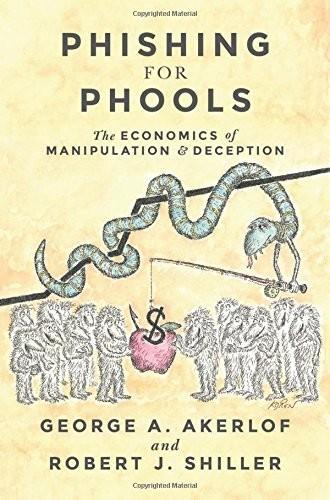
Phishing for Phools: The Economics of Manipulation and Deception
by
George A. Akerlof
,
Robert J. Shiller
and
Stanley B Resor Professor Of Economics Robert J Shiller
Published 21 Sep 2015
But not only was there a huge demand for these bonds at the prevailing interest rates, there was also, potentially, a huge supply of them. As far as the eye could see, going back to the beginning of the nineteenth century, the returns on stocks had been enormous. So large is the gap between the return on stocks and the return on bonds that this difference has earned a name: the equity premium. The equity premium was so large that, for example, a $100,000 trust fund initiated in 1925 and invested in treasuries would have been worth only $1.3 million seventy years later, in 1995; but the same trust fund invested and reinvested in stocks would have been worth more than $80 million.11 If you were so lucky as to have had a mildly rich great-grandmother who invested in a stock trust fund like this, you would not be poor.
…
Gary Smith, Standard Deviations: Flawed Assumptions, Tortured Data, and Other Ways to Lie with Statistics (New York: Duckworth Overlook, 2014). 9. Jesse Kornbluth, Highly Confident: The Crime and Punishment of Michael Milken (New York: William Morrow, 1992), p. 45. 10. Hickman, Corporate Bond Quality and Investor Experience, p. 10. 11. Jeremy J. Siegel and Richard H. Thaler, “Anomalies: The Equity Premium Puzzle,” Journal of Economic Perspectives 11, no. 1 (Winter 1997): 191. 12. United States Federal Deposit Insurance Corporation et al. v. Michael R. Milken et al. (1991), Southern District of New York (January 18), Amended Complaint Class Action, Civ. No. 91-0433 (MP), pp. 70–71. 13. See James B.
…
Chicago: University of Chicago Press, 1988. Shleifer, Andrei, and Robert W. Vishny. “The Takeover Wave of the 1980s.” Science 249, no. 4970 (1990): 745–49. Sidel, Robin. “Credit Card Issuers Are Charging Higher.” Wall Street Journal, October 12, 2014. Siegel, Jeremy J., and Richard H. Thaler. “Anomalies: The Equity Premium Puzzle.” Journal of Economic Perspectives 11, no. 1 (Winter 1997): 191–200. Sinclair, Upton. The Jungle. Mineola, NY: Dover Thrift Editions, 2001; originally published 1906. __________. Letter to the New York Times. May 6, 1906. Singh, Gurkirpal. “Recent Considerations in Nonsteroidal Anti-Inflammatory Drug Gastropathy.”
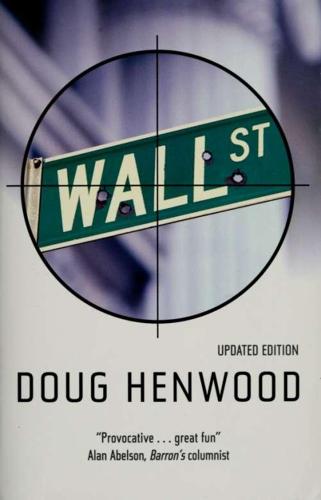
Wall Street: How It Works And for Whom
by
Doug Henwood
Published 30 Aug 1998
"The Noise Trader Approach to Finance," Journal of Economic Perspectives A (Spring), pp. 19-33. Shleifer, Andrei, and Robert W. Vishny (1986). "Large Shareholders and Corporate Control," Journal of Political Economy 9A, pp. 461-488. Shrikhande, Milind M. (1996). "Nonaddictive Habit Formation and the Equity Premium Puzzle," Federal Reserve Bank of Atlanta Working Paper 96-1 (February). Siegel, Jeremy J, (1992). "The Equity Premium: Stock and Bond Returns Since 1802," Financial Analysts Journal (February), pp. 28-38. Simmel, Georg (1978). The Philosophy of Money (Boston: Beacon Press). Simmons, Jacqueline (1996). "Home Prices Soar in Unexpected Places," Wall Street Journal, February 13- Simons, Katerina, and Stephen Cross (1991).
…
Over the very long term stocks greatly outperform any other asset class, but most people don't care about the long term; they want to be in today's hot sector, the day after tomorrow be damned. While stocks do outperform over the very long term, it's not really clear why; their performance can't be explained by most conventional financial models (Mehra and Prescott 1985; Siegel 1992). This is known as the equity premium puzzle in the trade. Many ingenious attempts have been made to solve the puzzle — like "nonaddictive habit formation" (Shrikhande 1996), whatever that means — but none have done so definitively. When measured against long-term economic growth — and Siegel's work covers the U.S. from 1802 through 1990, about as long-term as an anlysis can get — stock returns seem too high and bond returns too low.
…
When questioned, flacks from the libertarian Cato Institute — which is advised by the former Chilean cabinet minister who guided the transformation — make two points: the historical returns on stocks are higher than the implied return on Social Security, and money put into the stock market will promote real investment. As we've already seen, financial theory can't explain stock returns very well (the equity premium puzzle), and virtually no money put into the stock market goes into real investment. When confronted with these details, Cato's flacks sputter and mutter, but they have no solid answer other than to denounce the managerial skills of "government bureaucrats." Flacks also profess great faith in the public's ability to manage its retirement portfolio, but even people with advanced degrees don't really understand the basic arithmetic of interest rates, much less the complexities of modern financial markets.
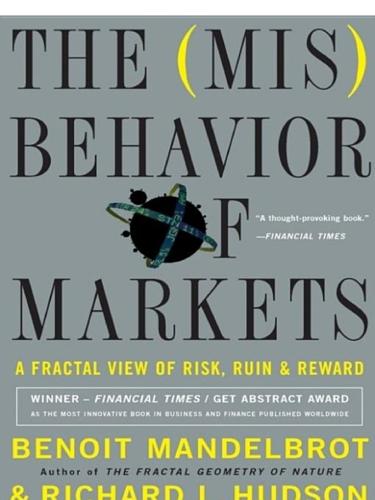
The Misbehavior of Markets: A Fractal View of Financial Turbulence
by
Benoit Mandelbrot
and
Richard L. Hudson
Published 7 Mar 2006
It is hard to predict, harder to protect against, hardest of all to engineer and profit from. Conventional finance ignores this, of course. It assumes the financial system is a linear, continuous, rational machine. That kind of thinking ties conventional economists into logical knots. Consider the so-called Equity Premium Puzzle, a chestnut of the scholarly literature since its discovery two decades ago by two young economists, Rajnish Mehra and Edward C. Prescott. Why is it that stocks, according to the averages, generally reward investors so richly? The data say that, over the long stretch of the twentieth century, stocks provided a massive “premium” return over that of supposedly safer investments, such as U.S.
…
Just one out-of-the-average year of losing more than a third of capital—as happened with many stocks in 2002—would justifiably scare even the boldest investors away for a long while. The problem also assumes wrongly that the bell curve is a realistic yardstick for measuring the risk. As I have said often, real prices gyrate much more wildly than the Gaussian standards assume. In this light, there is no puzzle to the equity premium. Real investors know better than the economists. They instinctively realize that the market is very, very risky, riskier than the standard models say. So, to compensate them for taking that risk, they naturally demand and often get a higher return. The same reasoning—that people instinctively understand the market is very risky—helps explain why so much of the world’s wealth remains in safe cash, rather than in anything riskier.
…
Multifractals should not be viewed as an “ad-hoc” structure but as the natural counterpart of two classical tools; the generating function (that is, the sequence of moments) and spectral analysis. Their parameters are intrinsic. Chapter XII Ten Heresies of Finance 230 “Consider the so-called Equity Premium Puzzle…” A good summary of their initial paper, and the difficulty it had in getting published, is provided in Mehra and Prescott 2003. 231 “The same reasoning…” For more on this, see Babeau, André and Sbano 2002. In fact, the precise asset allocation recommendations can vary from that 25-30-45 mix, depending on what the market is doing at any particular time. 232 “The ultimate fear…” See Embrechts, Klüppelberg and Mikosch 1997. 234 “Concentration is common…” See Lantsman, Major and Mangano 2002. 235 “One day when I was working…” Alexander’s “Filter” method attracted a great deal of attention–and similar methods have been devised and tried since his day.
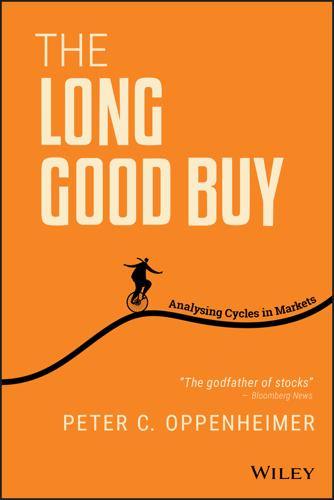
The Long Good Buy: Analysing Cycles in Markets
by
Peter Oppenheimer
Published 3 May 2020
The average bull market of a multi-asset (60/40) benchmark index in the US has been 81% (22% annualised) over 3.5 years. Notes 1 Ainger, J. (2019). 100-year bond yielding just over 1% shows investors’ desperation. Bloomberg [online]. Available at https://www.bloomberg.com/news/articles/2019–06–25/austria-weighs-another-century-bond-for-yield-starved-investors 2 Mehra, R., and Prescott, E. C. (1985). The equity premium: A puzzle. Journal of Monetary Economics, 15(2), 145–161. Chapter 3 The Equities Cycle: Identifying the Phases Although there are long-term shifts in the return profile of equities that depend on prevailing macroeconomic conditions (in particular, the trade-off between growth and interest rates), most equity markets show a tendency to move in cycles that relate to some degree to business cycles.
…
Efficient capital markets: A review of theory and empirical work. The Journal of Finance, 25(2), 383–417. Fama, E. F., and French, K. (1998). Value versus growth: The international evidence. Journal of Finance, 53(6), 1975–1999. Ferguson, N. (2012). The ascent of money. London, UK: Penguin. Fama, E. F., and French, K. (2002). The equity premium. Journal of Finance, 57(2), 637–659. Ferguson, R. W. (2005). Recessions and recoveries associated with asset-price movements: What do we know? Stanford Institute for Economic Policy Research, Stanford, CA. Filardo, A., Lombardi, M., and Raczko, M. (2019). Measuring financial cycle time. Bank of England Staff Working Paper No. 776 [online].
…
Available at https://ideas.ted.com/an-eye-opening-look-at-the-dot-com-bubble-of-2000-and-how-it-shapes-our-lives-today McNary, D. (2019, Jan. 2). 2018 worldwide box office hits record as Disney dominates. Variety [online]. Available at https://variety.com/2019/film/news/box-office-record-disney-dominates-1203098075/ Mehra, R., and Prescott, E. C. (1985). The equity premium: A puzzle. Journal of Monetary Economics, 15(2), 145–161. Minsky, H. P. (1975). John Maynard Keynes. New York, NY: Springer. Modigliani, E., and Blumberg, R. (1980). Utility analysis and the aggregate consumption function: An attempt at integration. The collected papers of Franco Modigliani.

Investing Demystified: How to Invest Without Speculation and Sleepless Nights
by
Lars Kroijer
Published 5 Sep 2013
Figure 5.7 MSCI World index since inception (dividends reinvested) Lars’s predictions So, in simple terms, on average I expect to make a 4–5% return a year above the minimal risk rate5 in a broad-based world equity portfolio. This is not to suggest that I expect this return to materialise every year, but rather that if I had to make a guess on the compounding annual rate in future it would be 4–5% (see Table 5.2). Note that while the equity premium here is compared to short-term US bonds I would expect the same premium to other minimal risk currency government bonds because the real return expectation of short-term US government bonds is roughly similar to that of other AAA/AA countries like the UK, Germany, Japan, etc. Table 5.2 Expected future returns (including returns from dividends) (%) Real1 Risk2 World equities 4.5–5.5 20.00 Minimal risk asset 0.50 Equity risk premium 4–5 1After inflation. 2See Chapter 6 for a discussion of issues with risk measures.
…
Many of you may be uncomfortable with having important stock market expectations simply being based on something as unscientific as historical returns or my ‘guesstimate’ of that data. Perhaps so, but until someone comes up with a reliably better method of predicting stock market returns it’s the best we have and a very decent guide. Also, we know that the equity premium should be something – if there were no expected rewards from investing in the riskier equities we would simply keep our money in low-risk bonds. Another problem with simplistically predicting a stable risk premium is that we don’t change it in line with the world around us. It probably sits wrong with most investors that the expected returns in future should be the same in the relatively stable period preceding the 2008 crash as it was during the peak of panic and despair in October 2008.
…
Someone willing to step into the market at a moment of high panic would expect to be compensated for taking that extra risk, suggesting that the risk premium is not a constant number, but in some way dependent on the risk of the market. At a time of higher expected long-term risk, equity investors will be expecting higher long-term returns. The equity premium outlined above is an expected average based on an average level of risk. In summary In the interest of making something as complicated as the world financial markets into something almost provocatively simple, Figure 5.8 outlines where we are in terms of returns after inflation. As an investor who seeks returns in excess of the minimal risk return you can add a broad portfolio of world equities.
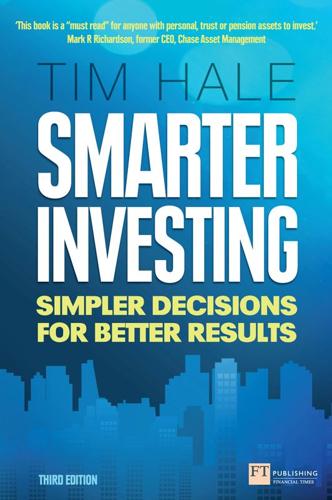
Smarter Investing
by
Tim Hale
Published 2 Sep 2014
The chances of a positive premium (which adds valuable returns to your portfolio) and the chances of a negative premium was explored in recent research (Fama and French, 2012). The authors concluded: ‘In a nutshell, the message … is that long time periods are required to be reasonably sure that the average equity premium, the average size premium, or the average value premium will be positive … Indeed, no matter how long the investment period, one can never be perfectly certain that the realized average premium will be positive. Such is the nature of risk and return!’ Figure 7.3 Chances of a negative risk premium Source: Data from Fama and French (2012) Reasonable allocations As such, allocations of between 10% and 20% (to each of value and smaller companies) of the Return Engine would be reasonable.
…
As such we have a reasonable time period to understand the broad characteristics associated with being an owner of companies. Figure 11.4 provides insight into the range of returns experienced across markets and over different time periods. Points of note include the fact that even over long periods of time, a strong equity premium is not assured, as amply demonstrated by the experience of Austria. Global diversification makes sense. Equities have outstripped bonds and cash by a material degree. Their cost of capital is higher – it is more risky to be an owner of companies than a lender. The proportion of time that UK equities have outperformed UK bonds and cash increases with holding periods is illustrated in Table 11.2.
…
Measuring it in the past is simple enough; however, like many arguments in investing, not only are there short-term exceptions to long-run averages, but also different time frames tell different stories. Academics and economists argue ad infinitum about the level of the equity risk premium but as the Economist succinctly put it in 2003: ‘Yes, over long periods equities have done better than bonds. But there is no equity “premium” – in the sense of a fairly predictable excess over bond returns on which investors can rely … Searching for a consistent, God-given premium is a fool’s errand.’ All I can say, as a practitioner rather than an academic, is that over the long run a premium appears to exist and should do so in the future, otherwise we would simply invest in bonds with lower risk.
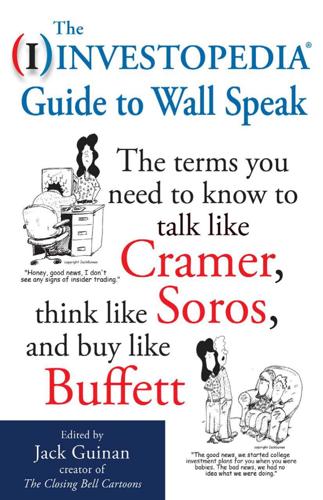
The Investopedia Guide to Wall Speak: The Terms You Need to Know to Talk Like Cramer, Think Like Soros, and Buy Like Buffett
by
Jack (edited By) Guinan
Published 27 Jul 2009
This excess return compensates investors for taking on the relatively higher risk of the equity market. The size of the risk premium will vary as the risk in a particular stock, or in the stock market as a whole, changes; high-risk investments are compensated with a higher premium. Also referred to as the equity premium. Investopedia explains Equity Risk Premium The risk premium is the result of the risk-return trade-off, in which investors require a higher rate of return on riskier investments. The risk-free rate in the market often is quoted as the rate on longerterm U.S. government bonds, which are considered risk-free because of the unlikelihood that the government will default on its loans.
…
For example, if one knew a given investment had a 50% chance of earning a 10% return, a 25% chance of earning 20%, and a 25% chance of earning –10%, the expected return would be equal to 7.5%: Expected Return = (0.5) (0.1) + (0.25) (0.2) + (0.25) (–0.1). Although this is what one would expect the return to be, there is no guarantee that it will be the actual return. Related Terms: • Coefficient of Variation • Return on Assets • Total Return • Equity Premium • Return on Equity The Investopedia Guide to Wall Speak 99 Expense Ratio What Does Expense Ratio Mean? The amount it costs an investment company to operate a mutual fund. An expense ratio is determined through an annual calculation in which a fund’s operating expenses are divided by the average dollar value of its assets under management.

Fooled by Randomness: The Hidden Role of Chance in Life and in the Markets
by
Nassim Nicholas Taleb
Published 1 Jan 2001
Writings by Soros: Soros (1988). Hayek: See Hayek (1945) and the prophetic Hayek (1994), first published in 1945. Popper’s personality: Magee (1997), and Hacohen (2001). Also an entertaining account in Edmonds and Eidinow (2001). CHAPTER 8 The millionaire next door: Stanley (1996). Equity premium puzzle: There is an active academic discussion of the “equity premium” puzzle, taking the “premium” here to be the outperformance of stocks in relation to bonds and looking for possible explanations. Very little consideration was given to the possibility that the premium may have been an optical illusion owing to the survivorship bias—or that the process may include the occurrence of black swans.
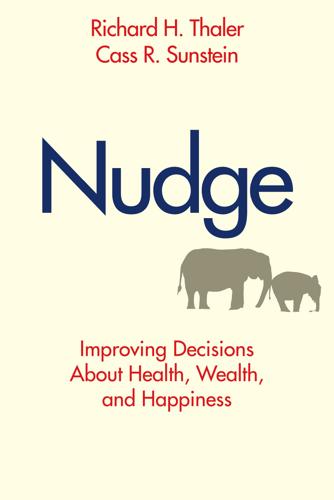
Nudge: Improving Decisions About Health, Wealth, and Happiness
by
Richard H. Thaler
and
Cass R. Sunstein
Published 7 Apr 2008
But if you had invested in mutual funds that held shares in the largest American companies (such as an S&P 500 index fund), your dollar would have grown into $2,658, a 10.4 percent rate of return, and if you had invested in a broad portfolio of the stocks of smaller companies, you could have earned even more. In economics jargon, in which stocks are referred to as equities, the difference in the returns between Treasury bills and equities is called the “equity premium.” This premium is considered to be compensation for the greater risk associated with investing in stocks. Whereas Treasury bills are guaranteed by the federal government, and are essentially risk free, investments in stocks are risky. Although the average rate of return has been 10 percent, there have been years when stocks have fallen by more than 30 percent, and on October 19, 1987, stock indexes fell 20 percent or more all around the world in a single day.
…
defined-benefit retirement plans defined-contribution retirement plans design: controlled by choice architects, details of, human factors incorporated into, informed, neutral, starting points inherent in, user-friendly Design of Everyday Things, The (Norman) Destiny Health Plan difficulty, degree of digital cameras discount pricing discrimination, laws against Disulfiram (antabuse) diversification heuristic divorce: and “above average” effect, and children, difficulty of obtaining, economic prospects affected by, law of, mandatory waiting period for, obtainable at will Doers dog owners, social pressures on Dollar a day incentive domestic partnership agreements “Don’t Mess with Texas,” eating: and conformity, and food display, and food selection, gender differences in Economist Econs: easy choices for, homo economicus, incentives for, investment decisions by, and money, not followers of fashion, Reflective Systems used by, unbiased forecasts made by, use of term education, accountability in, in Boston, in Charlotte, charter schools, child’s right to, and competition, complex choices in, controlled choice in, desegregation of, incentive conflicts in, No Child Left Behind, in San Marcos, Texas, school choice vouchers, status quo bias in, testing standards, test scores, underperforming in, in Worcester “efficient frontier,” Einstein, Albert elimination by aspects emails, Civility Check for Emanuel, Rahm Emergency Planning and Community Right to Know Act (1986) “emoticons,” employers: employee benefits offered by, profit-sharing plans of, and retirement plans endowment effect energy, invisibility of energy conservation: and cost-disclosing thermostats, and framing, and home-building industry, and social influences, voluntary participation programs in energy efficiency Energy Star Office Products Enron Corporation environmental issues, acid deposition program, air pollution, auto emissions, auto fuel economy, cap-and-trade system in, Clean Air Act, climate change, command-and-control regulation of, energy conservation, energy efficiency, energy use, feedback and information, greenhouse gas emissions, incentives for, international, Kyoto Protocol, nudges proposed for, ozone layer, recycling, risk labeling, and social influences, trading systems in, and tragedy of the commons, transparent costs of, voluntary participation programs Environmental Protection Agency (EPA), and auto fuel economy, Energy Star Office Products program, Green Lights program of, Toxic Release Inventory of Equities (stocks) equity premium ERISA (Employee Retirement Income Security Act of) error, expecting “everything matters,” evil nudgers expectations Experion Systems externalities FAFSA (free application for federal student aid) families, dispersion of Family and Medical Leave Act Federal Express, Federal Housing Administration (FHA) Federal Trade Commission (FTC) feedback, plans (college savings accounts) flexible spending accounts follow through failure to, Food and Drug Administration (FDA) food display food selection footnotes, uses of forced choice forcing function Ford, Harrison (k) plans framing France, organ donations in Franklin, Benjamin freedom of choice, danger of overreaching, elimination of, Just Maximize Choices, opposition to, and presumed consent, and required choice frequency Friedman, Milton friendly discouragement fungibility gains and losses gambling, low stakes, mental accounting in, self-bans, and strategy Gandhi, Mohandas gas tank caps Gateway Arch, St.
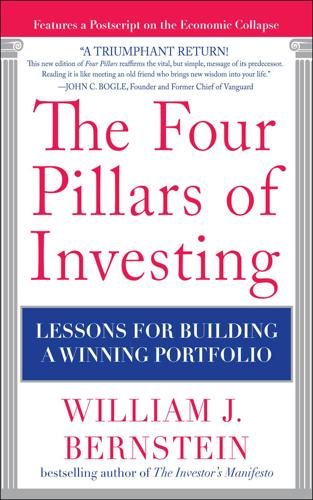
The Four Pillars of Investing: Lessons for Building a Winning Portfolio
by
William J. Bernstein
Published 26 Apr 2002
In Chapter 1, after looking at the long-term superiority of stocks over fixed-income securities, you may have found yourself asking the question, “Why doesn’t everybody buy stocks?” Clearly, in the long term, bonds were actually more risky than stocks, in the sense that in every period of more than 30 years, stocks have outperformed bonds. In fact, many academicians refer to this as “The Equity Premium Puzzle”—why investors allowed stocks to remain so cheap that their returns so greatly and consistently exceeded that of other assets. The answer is that our primordial instincts, a relic of millions of years of evolution, cause us to feel more pain when we suddenly lose 30% of our liquid net worth than when we face the more damaging possibility of failing to meet our long-term financial goals.
…
Smith, Edgar L., Stocks as Long Term Investments. Macmillan, 1924. Sobel, Dava, Longitude. Walker & Co., 1995. Strouse, Jean, Morgan: American Financier. Random House, 1999. White, Eugene N., ed., Crashes and Panics. Dow Jones Irwin, 1990. Chapter 7 Benzarti, S., and Thaler, Richard H., “Myopic Risk Aversion and the Equity Premium Puzzle.” Quarterly Journal of Economics, January 1993. Brealy, Richard A., An Introduction to Risk and Return from Common Stocks. M. I. T. Press, 1969. DeBondt, Werner F.M., and Thaler, Richard H., “Further Evidence On Investor Overreaction and Stock Market Seasonality.” Journal of Finance, July 1987.
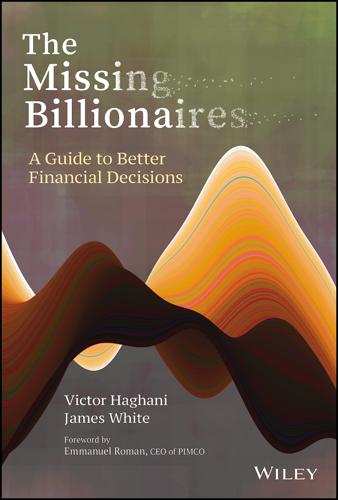
The Missing Billionaires: A Guide to Better Financial Decisions
by
Victor Haghani
and
James White
Published 27 Aug 2023
Why stop at 100? The case for perpetuities. The Grumpy Economist. Cochrane, J. (2021). Portfolios for long‐term investors. Review of Finance, 26(1), 1–42. Congressional Research Service. (2021). The US income distribution: Trends and issues . Constantinides, G. (1990). Habit formation: A resolution of the equity premium puzzle. Journal of Political Economy, 98(3), 519–533. Constantinides, G. and Duffie, D. (1996). Asset pricing with heterogeneous consumers. Journal of Political Economy, 104(2), 219–240. Cooper, A. and Howe, K. (2021). Vanderbilt: The rise and fall of an American dynasty. New York: HarperCollins.
…
Mauboussin, M. (2007). More than you know: Finding financial wisdom in unconventional places. New York: Columbia University Press. McLean, D. and Pontiff, J. (2016). Does academic research destroy stock return predictability? Journal of Finance, 71(1), 5–32. Mehra, R. and Prescott, C. (1985). The equity premium: A puzzle. Journal of Monetary, Economics 15(2), 145–161. Merton, R. (1969). Lifetime portfolio selection under uncertainty: The continuous‐time case. The Review of Economics and Statistics, 51(3), 247–257. Merton, R. (1971). Optimum consumption and portfolio rules in a continuous‐time model.
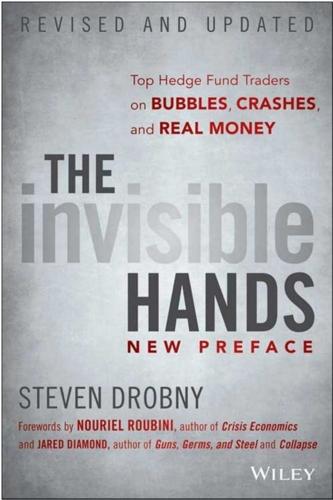
The Invisible Hands: Top Hedge Fund Traders on Bubbles, Crashes, and Real Money
by
Steven Drobny
Published 18 Mar 2010
Most private investments are simply equivalents of their public market counterparts wrapped up with an illiquidity risk premium. I am not aware of any plan that had an explicitly defined allocation to the illiquidity premium the way they had, for example, explicitly defined allocations to the equity premium or fixed income risk premium. Nevertheless, it was where they had chosen to allocate a great deal of their risk. However, even after taking into account deliberate allocations to illiquid assets, most plans still had more illiquidity risk than they realized. More overlooked were investments in assets that were liquid in good times but became very illiquid in periods of stress, including external managers who threw up gates, credit derivatives whereby whole tranches became toxic, and even crowded trades such as single stocks chosen according to well-known quantitative screens.
…
Fort Washington Capital Partners Group, “Why Over-Commitment Is Required to Achieve Target Exposures to Private Equity,” April 2007. Foundation Center. “Top Funders: Top 100 U.S. Foundations by Asset Size.” FoundationCenter.org, November 19, 2009. “Foundation Trusts ‘Must Plan for Spending Cuts’.” Health Service Journal, August 11, 2009. Fornari, Fabio. “The Size of the Equity Premium.” European Central Bank (ECB), January 2002. Gilbert, Katie. “He Dare Not Speak Their Name: Just Because This Danish Pension Officer Avoids Saying ‘Hedge Funds’ Doesn’t Mean He Doesn’t Love What They Represent.” Institutional Investor’s Alpha, July-August 2009. Golden, Daniel. “Cash Me If You Can.”
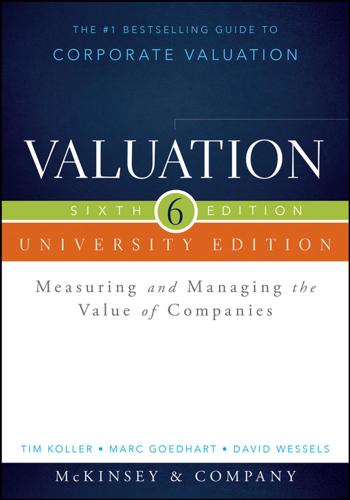
Valuation: Measuring and Managing the Value of Companies
by
Tim Koller
,
McKinsey
,
Company Inc.
,
Marc Goedhart
,
David Wessels
,
Barbara Schwimmer
and
Franziska Manoury
Published 16 Aug 2015
Even with the best statistical techniques, however, this number is probably too high, because the observable sample includes only countries with strong historical returns.5 Statisticians refer to this phenomenon as survivorship bias. Zvi Bodie writes, “There were 36 active stock markets in 1900, so why do we only look at two, [the UK and 3 E. Dimson, P. Marsh, and M. Staunton, “The Worldwide Equity Premium: A Smaller Puzzle,” in Hand- book of Investments: Equity Risk Premium, ed. R. Mehra (Amsterdam: Elsevier Science, 2007). 4 D. C. Indro and W. Y. Lee, “Biases in Arithmetic and Geometric Averages as Estimates of Long-Run Expected Returns and Risk Premia,” Financial Management 26, no. 4 (Winter 1997): 81–90; and M.
…
So a 3 percent drop in cost of equity would have increased the P/E from a typical trading range of 15 times to over 25 times. Yet in 2012, the P/E for the S&P 500 index was well within its normal trading range. 6 Z. Bodie, “Longer Time Horizon ‘Does Not Reduce Risk,”’ Financial Times, January 26, 2002. Marsh, and Staunton, “The Worldwide Equity Premium.” 8 The “yield to maturity” for U.S. government bonds is a good proxy for the expected return, since default expectations are virtually zero. The same is not true for corporate bonds, as we discuss later in this chapter. 9 After 2012, the yield on government bonds began a steady increase until dropping back below 2 percent in early 2015. 7 Dimson, ESTIMATING THE COST OF EQUITY 289 To overcome the inconsistency between interest rates on government bonds and market values of equities, we recommend using a synthetic riskfree rate.
…
Evidence from Analysts’ Earnings Forecasts for Domestic and International Stocks,” Journal of Finance 56, no. 5 (October 2001): 1629–1666; and W. R. Gebhardt, C. M. C. Lee, and B. Swaminathan, “Toward an Implied Cost of Capital,” Journal of Accounting Research 39, no. 1 (2001): 135–176. 15 E. F. Fama and K. R. French, “The Equity Premium” (Center for Research in Security Prices Working Paper 522, April 2001). 292 ESTIMATING THE COST OF CAPITAL Once you’ve estimated the real expected return, add an estimate of inflation that is consistent with your cash flow projections. Use the spread between the yield on inflation-protected bonds and regular government bonds to estimate the expected long-term inflation.
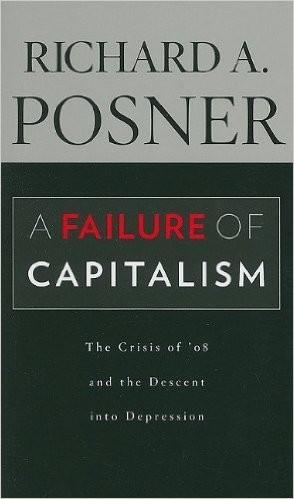
A Failure of Capitalism: The Crisis of '08 and the Descent Into Depression
by
Richard A. Posner
Published 30 Apr 2009
The bubble started in housing but eventually engulfed the financial industry. Low interest rates, aggressive and imaginative marketing of home mortgages, auto loans, and credit cards, diminishing regulation of the banking industry, and perhaps the rise of a speculative culture —an increased appetite for risk, illustrated by a decline in the traditional equity premium (the margin by which the average return on an investment in stocks exceeds that of an investment in bonds, which are less risky than stocks)—spurred speculative lending, especially on residential real estate, which is bought mainly with debt. As in 1929, the eventual bursting of the bubble endangered the solvency of banks and other financial institutions.
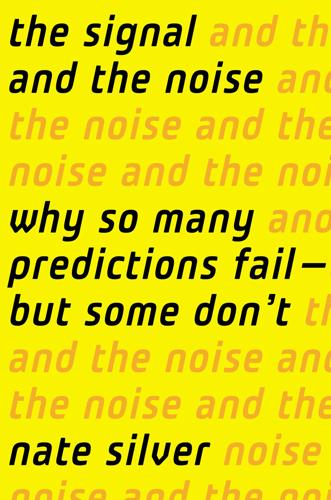
The Signal and the Noise: Why So Many Predictions Fail-But Some Don't
by
Nate Silver
Published 31 Aug 2012
.: of 1892, 334 of 1988, 67 of 2000, 11, 67, 68, 468–69 of 2008, 19, 48–49, 55, 56, 59, 60, 252, 426, 468 of 2010, 57–58, 61, 64 of 2012, 59, 65, 333, 336 electrical engineering, 173 Elements of Poker (Angelo), 325 Elias Baseball Analyst, 77 Ellsbury, Jacoby, 101 El Niño-Southern Oscillation (ENSO) cycle, 392, 393, 401, 403 Emanuel, Kerry, 384–85, 387 Emanuel, Rahm, 48 English Civil War, 4 Enlightenment, 2, 112 Enron, 356 entitlement, sense of, 326 epidemiology, 204–31 basic reproduction number in, 214–15, 215, 224, 225 extrapolation in, 212–16 self-canceling predictions in, 219–20 self-fulfilling predictions in, 217–18 SIR model in, 220–21, 221, 223, 225, 389 equity holdings, 357 equity premium puzzle, 349n ERA, 91, 95 ESPN, 294–95, 308 “Essay Toward Solving a Problem in the Doctrine of Chances,” 241 Estonia, 50–51, 52 ethnography, 228 European debt crisis, 198 European Union, 397–98 evacuations, 126–27 evolution, 292 EVTMX (Eaton Vance Dividend Builder A), 339–40 experience, 57, 312 Expert Political Judgment (Tetlock), 52 experts, 14, 52–53 definition of, 467 demand for, 202 extrapolation, 212–16 eyesight, 123, 124 FAA, 423 Fair, Ray C., 482 false negatives, 372 false positives, 245, 249–50, 251, 253 falsifiability, 14–15, 452 Fama, Eugene, 337–38, 339–40, 341, 346, 347, 353, 362, 363, 368n, 497 Fannie Mae, 33 fashion, 217 fatalism, 5 fate: American belief in control of, 10 in Julius Caesar, 4–5, 10 fat tails, 368, 496 fault lines, 162 favorite-longshot bias, 497 fear, vs. greed, 38 Federal Elections Commission, 69 Federal Open Markets Committee, 190–91 Federal Reserve, 37, 188 Federal Reserve Bank of Boston, 198 Federal Reserve Bank of New York, 465 Federal Reserve Bank of Philadelphia, 179 feedback: in climate system, 133 in economic forecasts, 188, 195 negative, 38, 39 positive, 38, 39, 368 on weather forecasting, 134–35, 386 FEMA, 141 Fenway Park, 79 Fesenko, Kyrylo, 238 Fine, Reuben, 272 First Amendment, 380 fiscal policy, 42, 186n Fischer, Bobby, 286–88, 287, 443 fish, in poker, 312, 316, 317–19 Fisher, Ronald Aylmer, 251–52, 254, 256–57, 259, 260 Fitch Ratings, 19, 24 FiveThirtyEight, 9, 48, 59, 61, 62, 62, 65, 67, 69, 314, 320, 468, 497 Intrade vs., 334, 335, 336–37 Five Tools, 95–96 Fleming, Alexander, 119 Flip That House, 32 Flip This House, 32 Floehr, Eric, 131, 132, 133–34, 474 flood prediction, 177–79, 178 floods, 145, 177–79, 178 flop, in poker, 299, 303, 303, 304, 305, 306, 310 Florida, 108 flu, 204–5 A/Victoria, 205–6, 208 bird, 209, 216, 229 H1N1, see H1N1 H3N2, 216 news about, 230 1957 outbreak of, 229 1968 outbreak of, 229 Spanish, 205, 211, 214, 224, 229 vaccine for, 206–8, 483–84 fluid dynamics, 118 football, 80n, 92–93, 185–86, 336 Ford, Gerald, 206, 208, 229 Ford, Henry, 212 forecasting: in baseball, 72–73, 76–77, 82–84, 93, 99–103; see also PECOTA; scouts in chess, 271, 289 by computer, 289 of earthquakes, see earthquake forecasting as planning and decision making under uncertainty, 5, 267 predictions vs., 5, 149 progress and, 5 updating of, 73 forecasting, global warming, 380–82 complexity in, 382 consensus in, 382–84 uncertainty in, 382 ForecastWatch.com, 132 foreshocks, 144, 154, 155–57, 476 Fort Dix, 204, 206, 208, 223–25, 229 Fort Riley, 205 fortune-telling, 5 Fourier, Joseph, 375 foxes, 53–54, 54, 55, 73 consensus process emulated by, 67 improvements in predictions by, 57, 68 as television pundits, 56 Fox News, 51n, 55, 56 France, 120 Franklin, Benjamin, 262 Freakonomics (Levitt and Dubner), 9 Freakonomics blog, 136–37, 334 FRED, 225–26 Freddie Mac, 33 free agents, 82, 90, 94, 99 free markets, 1, 128, 332, 369, 370, 451, 496–97 free will, 112 see also determinism French Wars of Religion, 4 frequentism, 252–53, 254, 259, 260 Freud, Sigmund, 53 Friedel, Frederic, 278–79, 282–83 Fritz, 278, 282n Frontline, 370n Fukushima nuclear reactor, 11, 168 Full Tilt Poker, 309 fundamental analysis, 341, 348, 354 fundamentals-based models, in elections forecasting, 68 futarchy, 201 Future Shock (Toffler), 12, 13 Galfond, Phil, 309 Galileo, 4, 254 Gallup polls, 364–65, 497 gambling, 232–61, 238 on baseball, 286 Bayesian philosophy’s esteem for, 255–56, 362 over-under line, 239–40, 257, 286 point spread, 239 Game Change, 59 Game of the Century, 286–88, 287 game theory, 284–85, 311, 419 Gates, Bill, 264 Gates, H.
…
Reliable stock market data only goes back 120 years or so—not all that much data if you really want to know about the long run. Statistical tests suggest that the true long-run return—what we might expect over the next 120 years—could be anywhere from 3 percent to 10 percent instead of 7 percent. The answer to what economists call the “equity premium puzzle”—why stocks have returned so much more money than bonds in a way that is disproportionate to the risks they entail—may simply be that the returns stocks achieved in the twentieth century were anomalous, and the true long-run return is not as high as 7 percent. * This is no surprise given how poor most of us—including most of us who invest for a living—are at estimating probabilities.

Money Changes Everything: How Finance Made Civilization Possible
by
William N. Goetzmann
Published 11 Apr 2016
In the 1970s, with Edgar Lawrence Smith mostly forgotten, two young Chicago professors, Roger Ibbotson and Rex Sinquefield, decided to return to the basic question of whether stocks were a good long-term investment. They used a database from the Chicago Center for Research in Security Prices called “CRSP.” They also collected data on US government bonds not previously studied by Smith or other analysts from the 1920s and 1930s and set about measuring the equity premium—the amount by which stock returns exceeded bond returns. Their finding? Stocks outperformed short-term US debt by about 6% per year over the period 1926 to 1976. Their sample fortuitously was completely independent of Edgar Lawrence Smith’s study and included not only the Great Depression and the Second World War but also the horrendous stagflation of the early 1970s, when US share prices in real terms dropped by as much as 50%.
…
See also investment entropy, 284 Ephesus, electrum coins at, 98–99, 101 equestrian class of Rome, 105–6, 112; publican societies and, 122, 123, 124 equity for debt swap: of John Law’s conglomerate, 355–58; of South Sea Company, 339–42 equity investments: Genoese debt converted into, 291–92; Keynes as advocate of, 471; by Rome’s equestrian class, 106, 123; Scholastic thinkers on risk premium for, 236. See also stock markets; stocks equity markets: eighteenth-century turn away from, 380–81, 382; globalization of, 403–4; of seventeenth-century London, 326. See also stock markets equity premium, 509 equity trading partnerships, Mesopotamian, 64; of Assur, 60–61; for Dilmun trade from Ur, 53–54 Essay on a Land Bank (Law), 351–53 An Essay upon Projects (Defoe), 323–25, 326–27, 342 European Central Bank, 220 European finance, 203, 205; assignable feudal rights framework for, 215–17, 219–20; born of political weakness and fragmentation, 203, 219, 520; eighteenth-century innovations in, 398–400; key stages in, 203; for medieval milling and mining firms, 303–4; overview of innovations in, 203; resurgence after year 1000 and, 226.

Skin in the Game: Hidden Asymmetries in Daily Life
by
Nassim Nicholas Taleb
Published 20 Feb 2018
Adaptation of Theorem 1 to Brownian Motion The implications of simplified discussion do not change whether one uses richer models, such as a full stochastic process subjected to an absorbing barrier. And of course in a natural setting the eradication of all previous life can happen (i.e., Xt can take extreme negative value), not just a stopping condition. The Peters and Gell-Mann argument also cancels the so-called equity premium puzzle if you add fat tails (hence outcomes vastly more severe pushing some level equivalent to ruin) and absence of the fungibility of temporal and ensemble. There is no puzzle. The problem is invariant in real life if one uses a Brownian-motion-style stochastic process subjected to an absorbing barrier.
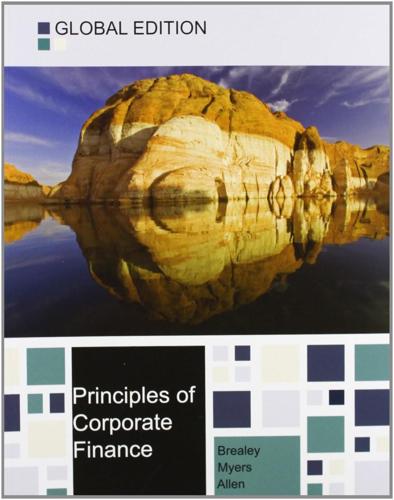
Principles of Corporate Finance
by
Richard A. Brealey
,
Stewart C. Myers
and
Franklin Allen
Published 15 Feb 2014
If that is true, investors ought to cut back their consumption when stock prices fall and wealth decreases. But the evidence suggests that when stock prices fall, investors spend at nearly the same rate. This is difficult to reconcile with high risk aversion and a high market risk premium. There is an active research literature on this “equity premium puzzle.” See R. Mehra, “The Equity Premium Puzzle: A Review,” Foundations and Trends in Finance® 2 (2006), pp. 11–81, and R. Mehra, ed., Handbook of the Equity Risk Premium (Amsterdam: Elsevier Handbooks in Finance Series, 2008). 12It is difficult to interpret the responses to such surveys precisely. For example, one is conducted every quarter by Duke University and CFO magazine and reported on at www.cfosurvey.org.
…
Sometimes you will see real risk premiums quoted—that is, the difference between the real market return and the real interest rate. If the inflation rate is i, then the real risk premium is (rm – rf)/(1 + i). For countries such as Italy that have experienced a high degree of inflation, this real risk premium may be significantly lower than the nominal premium. 15See E. F. Fama and K. R. French, “The Equity Premium,” Journal of Finance 57 (April 2002), pp. 637–659. Fama and French quote even lower estimates of the risk premium, particularly for the second half of the period. The difference partly reflects the fact that they define the risk premium as the difference between market returns and the commercial paper rate.
…
This is not nearly large enough to explain the difference in returns. There is no simple relationship between the return on the value- and growth-stock portfolios and beta. 19We discuss aversion to loss again in Chapter 13. The implications for asset pricing are explored in S. Benartzi and R. Thaler, “Myopic Loss Aversion and the Equity Premium Puzzle,” Quarterly Journal of Economics 110 (1995), pp. 75–92; and in N. Barberis, M. Huang, and T. Santos, “Prospect Theory and Asset Prices,” Quarterly Journal of Economics 116 (2001), pp. 1–53. 20There may be some macroeconomic factors that investors are simply not worried about. For example, some macroeconomists believe that money supply doesn’t matter and therefore investors are not worried about inflation.
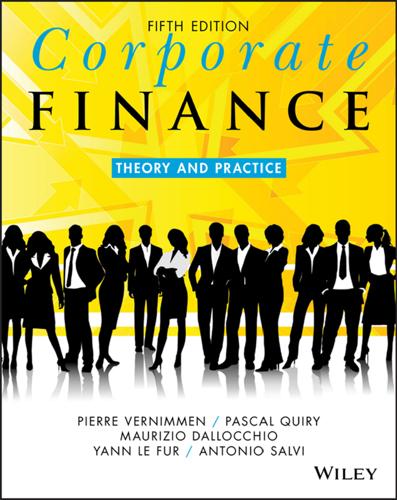
Corporate Finance: Theory and Practice
by
Pierre Vernimmen
,
Pascal Quiry
,
Maurizio Dallocchio
,
Yann le Fur
and
Antonio Salvi
Published 16 Oct 2017
Damodoran, Estimating risk-free rate, www.damodoran.com. A. Damodoran, Estimating risk premiums, www.damodoran.com. E. Dimson, P. Marsh, M. Staunton, The Triumph of the Optimists: 101 Years of Investment Returns, Princeton University Press, 2002. F. Fama, K. French, The equity premium, Journal of Finance, 57(2), 637–659, April 2002. P. Fernandez, The equity premium in 88 countries in 2014: A survey with 8228 answers, Working Paper, June 2014. P. Fernandez, J. Del Campo, Market risk premium used in 2010 by professors: A survey with 1,500 answers, Working Paper, IESE Business School, May 2010. W. Goetzmann, P. Jorion, Global stock markets in the twentieth century, Journal of Finance, 54(3), 953–980, June 1999.
…
Chen, Long-run stock returns: Participating in the real economy, Financial Analysts Journal, 59(1), 88–98, January–February 2003. M. Kritzman, Puzzles of Finance: Six Practical Problems and their Remarkable Solutions, John Wiley & Sons, Inc., 2002. R. La Porta, F. Lopez de Silanes, A. Shleifer, R. Vishny, Law and finance, Journal of Political Economy, 106(6), 1113–1155, December 1998. R. Mehra, The equity premium: Why is it a puzzle?, Financial Analysts Journal, 59(1), 54–69, January–February 2003. On chaos theory: E. Peters, Chaos and Order in Capital Markets, 2nd edn, John Wiley & Sons, Inc., 1996. Part Three Financial securities In Chapter 1 we wrote that a financial manager helps secure a company’s financing needs by selling securities to his investor clients.
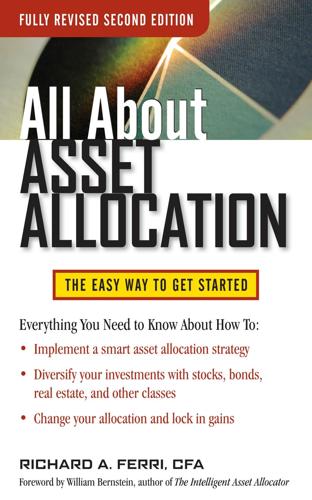
All About Asset Allocation, Second Edition
by
Richard Ferri
Published 11 Jul 2010
Consequently, a long-term strategic position must be taken, with a long-term estimation of the risk premium. Given the risk of stocks and the current valuation of the market, a good prediction for the long-term equity risk premium going forward is about 3 percent annualized over long-term corporate bonds. I’ll take a conservative view on the equity premium over corporate bonds and give it a 2 percent annualized expectation. U.S. equity expectation ⫽ expected long-term corporate bonds ⫹ equity risk premium There are other risk premiums that can be applied to the expected return on a portfolio in addition to the inherent risk of the equity market.
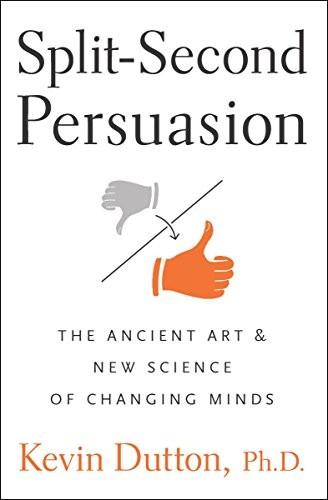
Split-Second Persuasion: The Ancient Art and New Science of Changing Minds
by
Kevin Dutton
Published 3 Feb 2011
‘I’m the coldest son-of-a-bitch you’ll ever meet,’ said Ted Bundy, who killed, decapitated and screwed – in that order -35 women over a four-year period.2 And he was right. But there are times, quite clearly, when that coldness comes in handy: when instead of actually costing lives, as in Bundy’s case, it can, in contrast, save them. The equity premium puzzle has long baffled financial experts. This is the tendency for large numbers of investors to invest in bonds as opposed to equities – especially during periods of stock-market decline – despite the fact that the latter, over time, have shown far better rates of return. Such conundrums as this – known as myopic loss aversion – have provided the impetus for a new, and somewhat timely, field of study: neuroeconomics.
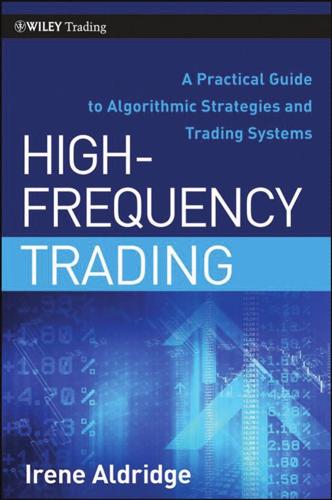
High-Frequency Trading: A Practical Guide to Algorithmic Strategies and Trading Systems
by
Irene Aldridge
Published 1 Dec 2009
“Event Studies in Economics and Finance.” Journal of Economic Literature XXXV, 13–39. Mahdavi, M., 2004. “Risk-Adjusted Return When Returns Are Not Normally Distributed: Adjusted Sharpe Ratio.” Journal of Alternative Investments 6 (Spring), 47–57. Maki, A. and T. Sonoda, 2002. “A Solution to the Equity Premium and Riskfree Rate Puzzles: An Empirical Investigation Using Japanese Data.” Applied Financial Economics 12, 601–612. Markowitz, Harry M., 1952. “Portfolio Selection,” Journal of Finance 7 (1), 77–91. Markowitz, Harry, 1959. Portfolio Selection: Efficient Diversification of Investments. New York: John Wiley & Sons.

Capital Ideas Evolving
by
Peter L. Bernstein
Published 3 May 2007
If you expect a Sharpe Ratio above 0.5—a return as high as one-half the volatility you experience—then clearly you want active risk to be the dominant risk in your portfolio.” Conservative investors holding a diversified portfolio half in equities and half in fixed-income can expect positive returns in the long run, but need to be realistic. Litterman’s group estimates the long-run equity premium at about 3 to 4 percentage points above bonds, although many economists currently expect less than that. This 50–50 portfolio, then, would create a real (inf lation-adjusted) return of roughly 1.5 percent to 2.0 percent over the long run—before fees and taxes. “There is no way to obtain a higher return without taking more risk,” Litterman argues.
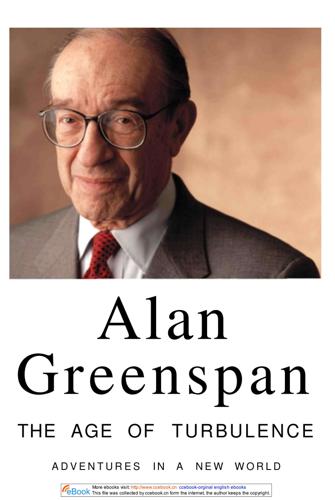
The Age of Turbulence: Adventures in a New World (Hardback) - Common
by
Alan Greenspan
Published 14 Jun 2007
A Federal Reserve System that will be confronted with the challenge of inflation pressures and populist politics that have been relatively quiescent in recent years If the Fed is prevented from constraining inflationary forces, we could be faced with: 4. A core inflation rate markedly above the 2.2 percent of 2006 5. A ten-year treasury note flirting with a double-digit yield sometime before 2030, compared with under 5 percent in 2006 6. Risk spreads and equity premiums significantly larger than in 2006, and 7. Therefore, yields on stocks greater than in 2006 (the result of a projected quarter century of subdued asset price increases through 2030), and, consonant with that, lower ratios of real estate capitalization 498 More ebooks visit: http://www.ccebook.cn ccebook-orginal english ebooks This file was collected by ccebook.cn form the internet, the author keeps the copyright.

The Meritocracy Trap: How America's Foundational Myth Feeds Inequality, Dismantles the Middle Class, and Devours the Elite
by
Daniel Markovits
Published 14 Sep 2019
See also Bartels, Unequal Democracy, 14. Bartels cites Anna Bernasek, “The Rich Spend Just Like You and Me,” New York Times, August 6, 2006, accessed November 19, 2018, www.nytimes.com/2006/08/06/business/yourmoney/06view.html, and Yacine Ait-Sahalia, Jonathan A. Parker, and Motohiro Yogo, “Luxury Goods and the Equity Premium,” Journal of Finance 59, no. 6 (2004). The economy as a whole grew at an average annual rate of just under 2.5 percent between 1990 and 2016, and average annual economic growth is forecast to be just 2 percent in the coming decade. Kevin Dubina, “Projections of the U.S. Economy, 2016–26: Slow Growth Continues,” Career Outlook, U.S.
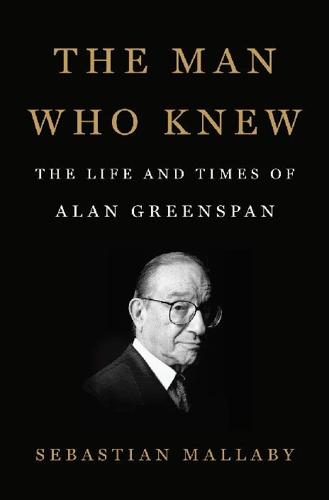
The Man Who Knew: The Life and Times of Alan Greenspan
by
Sebastian Mallaby
Published 10 Oct 2016
In this way, credit funds known as “SIVs” and “conduits” bridged the supposed divide between the federal funds rate and longer-term market interest rates. The general scramble for yield explained why, as Roger Ferguson observed, risky bonds were not being priced appropriately.42 “The potential snapback effects are large,” Greenspan went on. “We are always better off if equity premiums are moderate to slightly high or yields are moderate to slightly high because the vulnerability to substantial changes in market psychology is then obviously less.” Exuberant markets posed a risk, in other words. “In my view we are vulnerable at this stage to fairly dramatic changes in psychology,” Greenspan said ominously.

Empire of Things: How We Became a World of Consumers, From the Fifteenth Century to the Twenty-First
by
Frank Trentmann
Published 1 Dec 2015
Alexis de Tocqueville, Democracy in America (New York, 1840/1994), Vol. II, ch. 13, 138. 105. Euromonitor International, ‘Global Luxury Goods Overview’, June 2011; http://www.wisekey.com/en/Press/2011/Documents/Euromonitor_Report_for_FT_Business_of_Luxury_Summit_2011.pdf. 106. Y. Ait-Sahalia, J. A. Parker & M. Yogo, ‘Luxury Goods and the Equity Premium’, Journal of Finance 59, no. 6, 2004: 2959–3004. 107. ‘Falso di moda’, symposium at Palazzo Medici Riccardi, Florence, 30 Nov. 2007. 108. Pamela N. Danziger, Let Them Eat Cake: Marketing Luxury to the Masses – As Well as the Classes (Chicago, 2005). 109. Offer, Challenge of Affluence. The decline of self-control is case specific and should not be overstated.